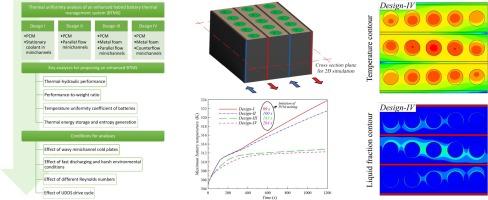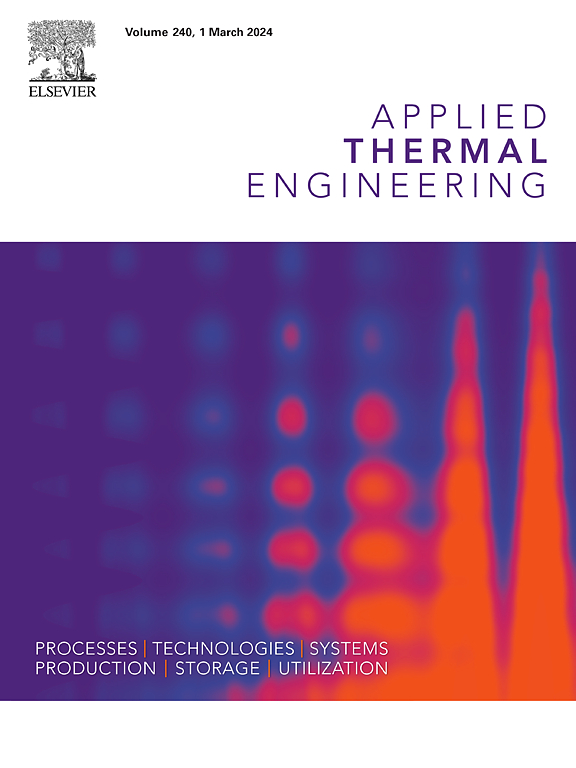Thermal uniformity analysis of a hybrid battery pack using integrated phase change material, metal foam, and counterflow minichannels
IF 6.1
2区 工程技术
Q2 ENERGY & FUELS
引用次数: 0
Abstract
This study investigates the thermal performance and temperature uniformity of a hybrid battery thermal management system (BTMS) that integrates phase change material (PCM), metal foam, and minichannels. Computational fluid dynamics is used to model the PCM melting process and heat transfer between all components. The primary goal of the work is to investigate BTMS architectures which can enhance thermal uniformity and prevent critical temperature rise in a high-voltage battery pack under fast discharging and real-world driving cycle. Four BTMS designs are compared. The design that integrates PCM, metal foam, and counterflow minichannels is shown to have the best performance. At low pumping power (coolant Reynolds number Re = 10), this design reduces the peak battery temperature by 11.5 K compared to a design employing pure PCM only. This configuration also ensures a temperature difference of less than 5 K among individual battery cells, addressing thermal safety considerations and extending battery lifespan. Further analysis revealed that the inclusion of metal foam delays PCM melting, enhances both system and battery thermal uniformity, and offers a higher performance-to-weight ratio compared to designs without metal foam. Although wavy-shaped minichannels offer minimal temperature improvement (0.3 K) over straight minichannels, their higher cost and increased pumping power requirements do not justify their practicality. Under both fast discharging and real driving conditions, the first design with pure PCM provides uniform heat distribution within batteries but fails to maintain the maximum battery temperature within the optimal range. Overall, this study highlights the effectiveness of the proposed hybrid BTMS design in providing uniform temperature distribution and maintaining the maximum battery temperature within the optimal range under harsh environmental conditions, fast discharging, and the Urban Dynamometer Driving Schedule (UDDS) drive cycle.

使用集成相变材料、金属泡沫和逆流微型通道的混合电池组的热均匀性分析
本研究探讨了集成相变材料 (PCM)、金属泡沫和微型通道的混合电池热管理系统 (BTMS) 的热性能和温度均匀性。计算流体动力学用于模拟 PCM 熔化过程和所有组件之间的热传递。这项工作的主要目标是研究 BTMS 架构,以提高热均匀性,防止高压电池组在快速放电和实际驾驶循环下出现临界温度升高。对四种 BTMS 设计进行了比较。结果表明,集成了 PCM、金属泡沫和逆流微型通道的设计性能最佳。在低泵功率下(冷却剂雷诺数 Re = 10),与仅采用纯 PCM 的设计相比,这种设计可将电池峰值温度降低 11.5 K。这种配置还能确保单个电池单元之间的温差小于 5 K,从而解决热安全问题并延长电池寿命。进一步的分析表明,与不使用金属泡沫的设计相比,加入金属泡沫可延缓 PCM 熔化,提高系统和电池的热均匀性,并提供更高的性能重量比。虽然波浪形微型通道比直线型微型通道的温度改善幅度最小(0.3 K),但其较高的成本和增加的泵功率要求并不能证明其实用性。在快速放电和实际驾驶条件下,第一种使用纯 PCM 的设计在电池内提供了均匀的热量分布,但未能将电池的最高温度保持在最佳范围内。总之,本研究强调了所提出的混合 BTMS 设计在恶劣环境条件、快速放电和城市测功机驾驶时间表 (UDDS) 驱动循环下提供均匀温度分布和将最高电池温度保持在最佳范围内的有效性。
本文章由计算机程序翻译,如有差异,请以英文原文为准。
求助全文
约1分钟内获得全文
求助全文
来源期刊

Applied Thermal Engineering
工程技术-工程:机械
CiteScore
11.30
自引率
15.60%
发文量
1474
审稿时长
57 days
期刊介绍:
Applied Thermal Engineering disseminates novel research related to the design, development and demonstration of components, devices, equipment, technologies and systems involving thermal processes for the production, storage, utilization and conservation of energy, with a focus on engineering application.
The journal publishes high-quality and high-impact Original Research Articles, Review Articles, Short Communications and Letters to the Editor on cutting-edge innovations in research, and recent advances or issues of interest to the thermal engineering community.
 求助内容:
求助内容: 应助结果提醒方式:
应助结果提醒方式:


